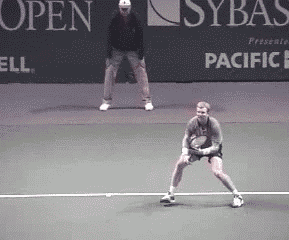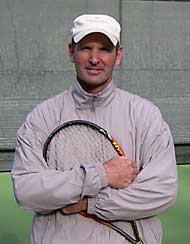|
TennisOne Lessons Relax the Arm and Use the Wrist for Proper Acceleration Doug King
Getting the body and the racquet to swing in proper coordination can be tricky business. The technique and timing of this system varies from shot to shot to produce variations of power, spin, and trajectory. The coordination of this motion is difficult enough on shots that require little or no generation of power, such as a volley or blocked return of serve. However, for a stroke that requires the generation of additional power, the undertaking can be quite challenging. In a volley situation that requires minimal generation of power the coordination of the body to the racquet is relatively simple. They move more together than a stroke like a serve or a powerful groundstroke. Think of a golfer putting and how the arms, the body, and the club all move in a single piece. Compare this to the stroke a golfer uses to drive a ball 300 yards - the swing is much more complicated. The same is true in tennis. In this article I would like to address two components of this equation of swing timing. One is the ability to time what I call the "unweighting" or relaxing of the arm, and second is the use of the wrist and variations in wrist positions in the generation of power. We will also look at the natural whip qualities that this produces to generate maximum speed in an efficient stroke system.
Deadening the Arm In an efficient stroke movement it is critical to keep the arm relaxed and fluid. A tight, stiff arm is a slow arm so an important element to correct swing speed is learning to drain tension from the arm. A loose arm starts with a relaxed grip on the handle. This is where most arm tension comes from so it is critical to keep the hand relaxed. Although it may sound simple to keep the arm relaxed, it is actually a bit tricky. One problem is that if the arm is totally relaxed it will simply hang down at the side of the body. Instead, the lifting and dropping of the arm should be controlled more from the shoulder and side of the body rather than by the hand. Another difficulty is that most players will over tighten the arm in an effort to get the arm to swing. Instead the arm should be controlled more from the shifts of the hitting side of the body (passive action). Finally, it is simply difficult to relax when you are hitting a tennis ball. If you watch the accompanying video on McEnroe, notice how his arm seems to simply flow against the ball in a solid yet relaxed way. The arm is kept relaxed and in doing so it both better connects to the body and also responds to the shifts of the body, especially the shoulder through the hit.
In many martial arts they speak of keeping the weight on the underside of the arm. This simply means to feel as though the mass of the arm has sunk to the underside of the arm and is simply being pulled down by gravity. This feel is key to proper movement and coordination. We often talk of keeping our weight down or keeping a low center of gravity. This is very directly related to the feel in the hands and the arms. By keeping the arms in a more relaxed, deadened feel, the arms are able to move fluidly and yet predictably and consistently. The arms will tend to shift more freely with less jerky, interrupted movements caused by undue tightening in the hands and wrists. Keeping the arms relaxed also promotes overall balance by helping to maintain a lower center of gravity and reducing stress on the body core segments. The Use of the Wrist in Groundstrokes
If we watch most top pros, we will see that they keep the wrist in a relatively neutral position through much of the backswing and then let the wrist fold back into it's final hitting position often times just before contact. This last moment folding back of the wrist occurs just as the arm is pulled forward into the contact by the hip and shoulder rotation. This last moment wrist layback (or wrist cocking) is most pronounced in players with the highest swing speeds such as Federer, Nadal, Henin, Djokovic, Roddick, and also to a lesser degree by players with flatter strokes like Agassi and Davydenko. It is achieved by letting the wrist stay relaxed and producing a slight backwards flex in the wrist and a rotation of the forearm (supination) as the arm is simultaneously pulled forward by the rotation of the hitting side of the body. At this moment of pull of the racquet into the ball which signals the forceful acceleration phase of the stroke, there is both forward pull of the arm and backwards rotation of the racquet creating a dynamic tension in the shoulder that, when released, further enhances the acceleration of the arm. This dynamic of letting the racquet "fold back" very close to contact not only takes a good deal of flexibility and strength, but also timing and faith. It is contrary to most people's sensibilities to create a "backwards" movement of the racquethead so close to the contact of the ball. For many it feels as though the ball is going to be struck with the butt of the racquet. In fact this technique of pulling the butt of the racquet at the ball the moment prior to contact is a very good technique to learn more acceleration into the ball.
This relaxing and folding back is not necessarily a natural movement as it can cause a feeling of control loss and of being late. Most people feel insecure rotating the racquet face back from the ball just prior to contact. First of all they tend to overgrip the racquet as they approach contact and instead of flexing back, the wrist either stiffens or even makes a forward snap. Not only do most people physically over tighten, psychologically they also feel the urge to line the racquet up with the ball quite early so as to insure a sense of "accurate" alignment to the ball. This over gripping and early aligning of the racquet face to the ball will result in more of a "push" hit, often referred to as "steering" the ball. This is the mistake that players make when you hear the announcers comment that they lacked "acceleration" through the hit. Proper acceleration can only be achieved if the racquet face is angled away from the ball until the very latest possible moment and then released with a powerful rotational "snap" or flex involving the entire hitting side of the body (hips, shoulders, and arm). This angling away from the ball and then flexing onto the ball is similar to how a door slams shut by rotating on it's hinges. This is the same kind of rotation that the body and racquet make at the final squaring action of the racquet to the ball. Your comments are welcome. Let us know what you think about Doug King's article by emailing us here at TennisOne.
Doug is one of the country's foremost tennis teaching innovators. Founder of Acceleration Tennis, a revolutionary teaching system, King is leading the way in reinterpreting the traditional tennis model. Doug King is currently Director of Tennis at Meadowood Napa Valley ( www.meadowood.com ), a Relaix Chateau Resort in St. Helena , CA . For more information on Acceleration Tennis please email Doug King at dking@meadowood.com. |



 Doug King studied with legendary tennis coach Tom Stow and was a
former California State Men's Singles Champion
and the former number one men's player of Northern California.
Doug King studied with legendary tennis coach Tom Stow and was a
former California State Men's Singles Champion
and the former number one men's player of Northern California.